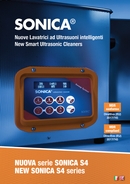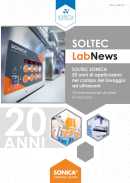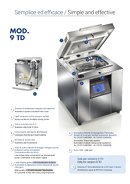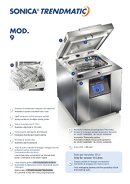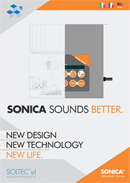SONICA® CL4% Concentrated Aqueous Disinfectant
Submitted by soltec-admin on Sat, 05/01/2010 - 23:30

| Name | ph | Dilution in water % | Bath Cleaning temperature |
|---|---|---|---|
| AC | 2.50 | 10-10 | 50 |
| AF | 0.00 | 5-10 | 40 |
| CL4% | 7.00 | 2-4 | 30 |
| DW1 | 0-0 | ||
| ML | 10.00 | 5-10 | 65 |
| PCB | 11.00 | 0-0 | 40 |
| RC | 13.00 | 0-0 | 60 |
| RG | 8.00 | 0-0 | 40 |
| SF | 13.00 | 8-10 | 60 |
| UG | 7.00 | 5-10 | 40 |
| Winch Clean 1 | 7.00 | 1-10 | 60 |
| Winch Clean 2 | 14.00 | 5-10 | 70 |
| Name | Alluminium | Steel | Brass | Copper |
|---|---|---|---|---|
| AC | 1 | 4 | 4 | 4 |
| AF | 0 | 2 | 1 | 1 |
| CL4% | 4 | 5 | 5 | 5 |
| DW1 | 5 | 5 | 5 | 5 |
| ML | 5 | 5 | 5 | 5 |
| PCB | 2 | 5 | 3 | 4 |
| RC | 0 | 5 | 2 | 2 |
| RG | 5 | 5 | 5 | 5 |
| SF | 0 | 5 | 2 | 2 |
| UG | 5 | 5 | 5 | 5 |
| Winch Clean 1 | 5 | 5 | 5 | 5 |
| Winch Clean 2 | 0 | 5 | 2 | 2 |
| Name | Oil | Grease | Oxide | Limestone | Plaster | Alginate | Cement | Water | Organic residues |
|---|---|---|---|---|---|---|---|---|---|
| AC | 1 | 1 | 3 | 3 | 0 | 0 | 0 | 0 | 3 |
| AF | 2 | 2 | 5 | 5 | 0 | 0 | 0 | 0 | 3 |
| CL4% | 2 | 1 | 0 | 0 | 0 | 0 | 0 | 0 | 5 |
| DW1 | 0 | 0 | 0 | 0 | 0 | 0 | 0 | 5 | 0 |
| ML | 5 | 4 | 2 | 0 | 0 | 0 | 0 | 0 | 4 |
| PCB | 2 | 2 | 2 | 0 | 0 | 0 | 0 | 0 | 4 |
| RC | 3 | 2 | 0 | 0 | 0 | 0 | 5 | 0 | 4 |
| RG | 0 | 0 | 0 | 0 | 5 | 4 | 0 | 0 | 2 |
| SF | 3 | 2 | 1 | 0 | 0 | 0 | 5 | 0 | 4 |
| UG | 4 | 1 | 1 | 0 | 0 | 0 | 0 | 0 | 4 |
| Winch Clean 1 | 3 | 2 | 0 | 0 | 0 | 0 | 0 | 0 | 4 |
| Winch Clean 2 | 5 | 5 | 1 | 0 | 0 | 0 | 0 | 0 | 4 |
| Name | Dewatering and coating | Descale | Detergent | Disinfectant |
|---|---|---|---|---|
| AC | 0 | 4 | 3 | 0 |
| AF | 0 | 5 | 2 | 0 |
| CL4% | 0 | 0 | 4 | 5 |
| DW1 | 5 | 0 | 0 | 0 |
| ML | 0 | 0 | 5 | 0 |
| PCB | 0 | 0 | 4 | 0 |
| RC | 0 | 5 | 0 | 0 |
| RG | 0 | 5 | 1 | 0 |
| SF | 0 | 0 | 4 | 0 |
| UG | 0 | 0 | 4 | 0 |
| Winch Clean 1 | 0 | 0 | 5 | 0 |
| Winch Clean 2 | 0 | 0 | 3 | 0 |
Ultrasonic Cleaner liquid CL4%
Concentrated Disinfectant Aqueous Solution for medical devices particulary suitable for SONICA decontamination tank and SONICA® ultrasonic cleaners.

Application Fields
- Decontamination and simultaneous detergency of surgical instruments and medical devices
- Temporary sterile conservation of surgical instruments
Action Mechanism
Chlorexidine reacts with the negatively charged groups that are found on the cell surface.
For this reason, when it comes into contact with bacterial suspensions, it is absorbed immediately,
causing an irreversible loss of cytoplasm components, which damages the cell membrane and inhibits enzymes.
Cetrimide is a quaternary ammonium salt that reduces surface tension in the point of contact and has precipitant,
complexing and denaturing effects on bacteria proteins, causing enzyme changes in the cytoplasm membrane.
Germicidal Activity
Chlorexidine acts on vegetative bacteria, yeasts, fungi, several protozoa, viruses (HIV) and salmonella.
Cetrimide acts as a bactericide above all on gram-positive bacteria; it has varying fungistat properties
and acts as a virucide against lipophilic viruses. The action of the product is superior to that of its single components.
Its bactericidal actions are reduced by the presence of organic material (serum).
In hospital usage SONICA® CL4% is mainly recommended for its action against gram-negative and gram-positive bacteria,
as well as lipophilic viruses (HIV).
From the tests made, SONICA® CL4% has shown that it acts against such bacteria as Citrobacter freundi,
Serratia marcescens, Pseudomonas aeruginosa ATCC 15442, Pseudomonas aeruginosa ATCC 14502, Proteus rettgeri,
Staphylococcus aureus ATCC 114, Staphylococcus aureus ATCC 6538, and Klebsiella pneumoniae.
Research
The efficiency of a decontamination procedure by sonication for different dental instruments after experimental
microbial and viral contamination was tested.
Both germicidal and virucidal activity of sonication in presence or absence of a cationic bio-biguanid disinfectant
was assessed following three different disinfection/sterilisation protocols.
Dental instruments were contaminated with a mixed culture of Streptococcus faecium, Staphylococcus sp., Pseudomonas aeruginosa,
Mycobacterium sp., Escherichia coli and Bacillus subtilis, or with Polio virus type 1 and Herpesvirus simplex type 1
(HHV1, following the new herpesvirus denomination), exposed to ultrasonic treatment in an ultrasonic bath and the surviving
microorganisms titered.
The results showed that an effective disinfection of dental instruments, expressed by an equal or higher
than 4 logs microbial and viral reduction, can be obtained after 15 min or 10 min sonication in the ultrasonic cleaner equipped
with a Sweep System Technology. Conversely, by the combined action of chemical disinfection and ultrasonic treatment
in the same device, a sterilising effect was obtained after only 5 min for microbial and after 10-15 min for virally
contaminated instruments.
The synergistic effect of chemical and physical means, as already accepted as an effective
cleaning procedure of medical instruments, can therefore be applied to obtain a safe and effective sterilisation of dental
instruments potentially contaminated by organic fluids and dental material harbouring pathogenic microbes and viruses.
Authors:
*Patrizia Di Gennaro, *Giuseppina Bestetti, °Antonia Radaelli, §Manuela Paganini, §Carlo De Giuli Morghen,
§Margherita Neri
*Department of Environmental Sciences, University of Milano-Bicocca, 20126 Milano, Italy.
Departments of §Medical Pharmacology and °Pharmacological Sciences, University of Milano, 20129 Milano, Italy.
Corresponding author: Prof. Giuseppina Bestetti, Department of Environmental Sciences, University of Milano-Bicocca,
P.zza della Scienza, 1 20126 Milano Italy, Phone: 0039-2-64482925; Fax: 0039-2-64482996; E-mail:
Giuseppina.Bestetti@unimib.it

